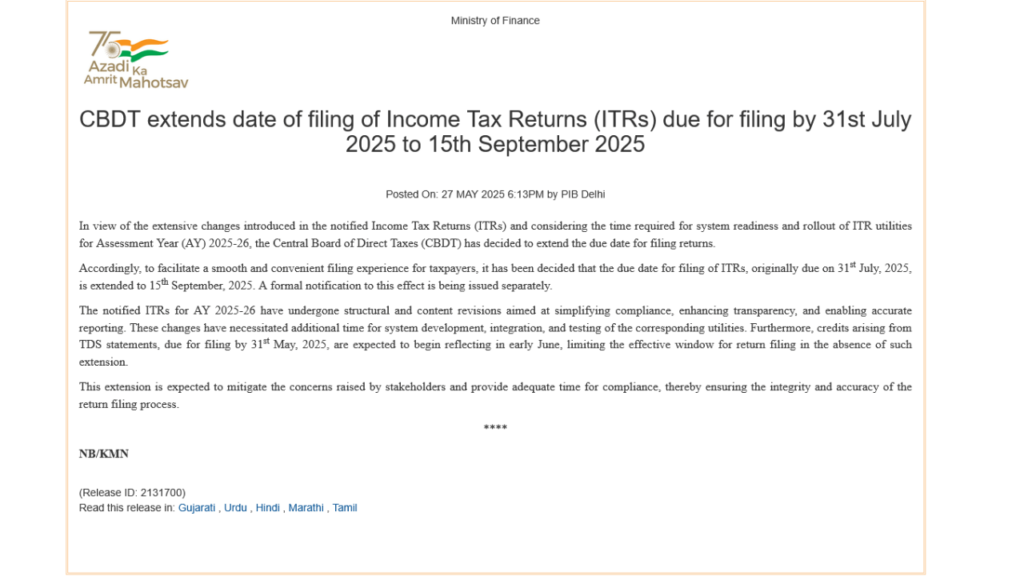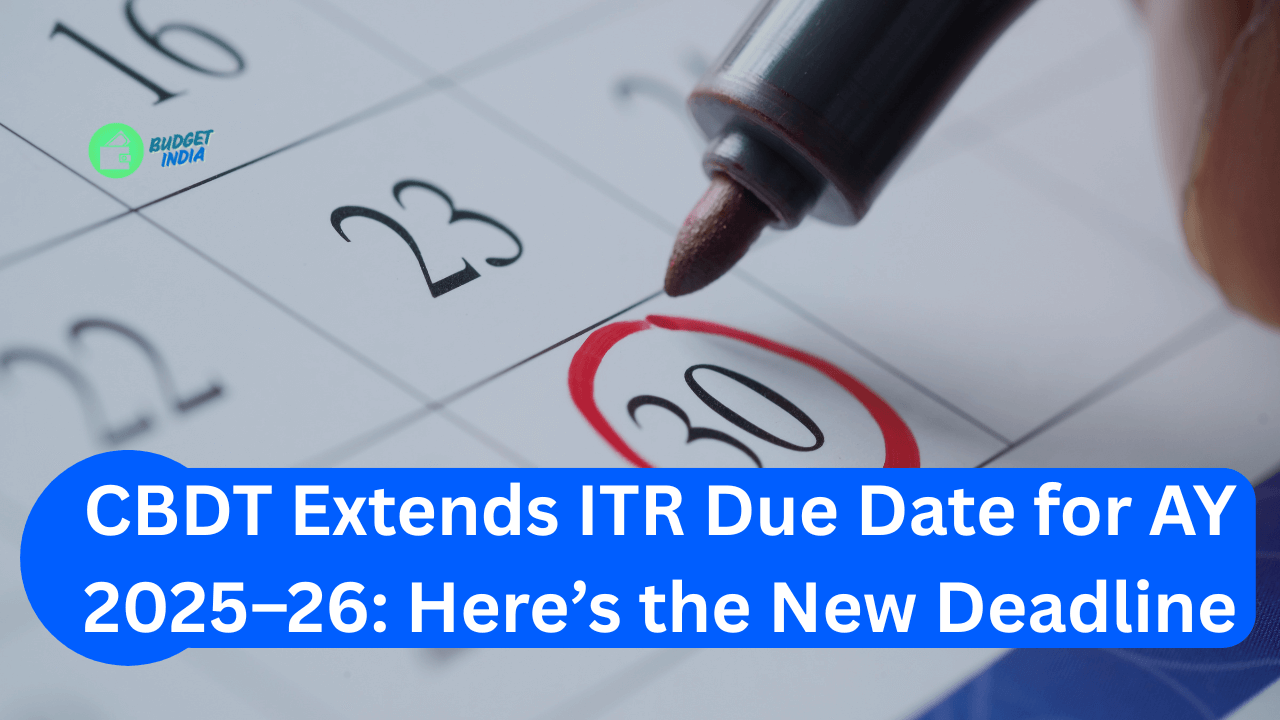Every year, like clockwork, the last week of July sees a mad rush. Salaried individuals, freelancers, small businesses—everyone scrambling to beat the ITR due date of July 31. And every year, many quietly hope: “Maybe the government will extend it again.”
Well, this time, they did.
The Central Board of Direct Taxes (CBDT) has officially extended the ITR due date for AY 2025–26 (i.e., for income earned in FY 2024–25) from July 31 to September 15, 2025. That’s an extra 46 days of breathing room. But this extension isn’t just a token gesture—it’s a strategic move in response to deeper systemic issues.

Read More: FY 2025–26 Income Tax Regimes: What You Need to Know
So, Why the Extension? Here’s What’s Actually Going On
This wasn’t some last-minute surprise.
The tax department has been rolling out updates to ITR forms this year. They’ve tweaked structures, added reporting layers, and introduced more clarity around certain sections like capital gains and the new tax regime.
But here’s the problem—every time they update the forms, the systems need to catch up. That means:
- The e-filing portal needs new utilities.
- TDS credits need to reflect properly in Form 26AS.
- AIS (Annual Information Statement) and TIS (Taxpayer Info Summary) need to sync without errors.
Add to this the fact that employers have until May 31 to submit their TDS statements, and Form 16s start showing up mid-June at best. So, filing before that? Risky. You’d likely get stuck filing a revised return later.
The CBDT knows this. And this extension is an acknowledgment that pushing people to file returns without complete data leads to more pain than productivity.
Who Gets the Benefit?
This extension is specifically for non-audit cases. In simple terms, here’s who benefits:
- Salaried individuals
- Freelancers, consultants, and self-employed professionals
- Hindu Undivided Families (HUFs)
- AOPs (Association of Persons) and BOIs (Body of Individuals)
Their new ITR due date is September 15, 2025.
But if you run a business that requires a statutory audit, your due date remains October 31, 2025. For companies involved in transfer pricing? The deadline is November 30, 2025.
What Does This Mean for You?
If you fall into the non-audit category, here’s what this means in plain English:
- You’ve got more time.
Use it wisely. Collect your Form 16, match it with Form 26AS, check your AIS and TIS, and review any capital gains statements if you’ve dabbled in mutual funds or stocks. - Avoid the penalty trap.
If you miss the September 15 deadline, here’s what you’re looking at:- ₹5,000 late fee if your income > ₹5 lakh
- ₹1,000 late fee if your income ≤ ₹5 lakh
- 1% monthly interest under Section 234A for unpaid tax
- Understand the new ITR forms.
For example, ITR-1 (Sahaj) can now be used by individuals with long-term capital gains up to ₹1.25 lakh. Earlier, they had to go for ITR-2. These small tweaks matter. They can save you time—and possibly money—if you choose the right form from the get-go. - Wait till June 15—seriously.
Most tax professionals suggest waiting until mid-June before filing. That’s when all TDS data is expected to reflect properly. Filing before that might lead to mismatches. And that’s a headache you don’t want.
Key ITR Deadlines for AY 2025–26
| Taxpayer Category | ITR Due Date |
|---|---|
| Individuals (Non-audit cases) | September 15, 2025 |
| Businesses requiring audit | October 31, 2025 |
| Transfer pricing cases | November 30, 2025 |
| Belated/Revised Return | December 31, 2025 |
| Updated Return (ITR-U) | March 31, 2030 |
Final Word: Don’t Sit on This
Sure, the ITR due date just moved. But if history is any indication, the last week of August will be just as chaotic as July ever was.
So yes, use the time to get your documents in order. Wait for your TDS and AIS to reflect correctly. Understand the form changes. But once everything’s ready—file it. Don’t let procrastination turn an extended deadline into a missed opportunity.
The Income Tax Department has done its part.
Now it’s your move.
Frequently Asked Questions (FAQs)
1. What is the new ITR due date for AY 2025–26?
The Central Board of Direct Taxes (CBDT) has extended the Income Tax Return (ITR) due date for Assessment Year 2024–25 from July 31, 2025, to September 15, 2025. This extension applies to most individual taxpayers and those not requiring an audit.
2. Who is eligible for the extended ITR due date?
This extension benefits individuals, Hindu Undivided Families (HUFs), Associations of Persons (AOPs), and Bodies of Individuals (BOIs)—as long as their accounts do not require an audit under income tax laws.
3. Will I be charged a penalty if I miss the new ITR due date?
Yes. If you file after the extended deadline:
- You’ll pay a ₹5,000 late fee if your total income exceeds ₹5 lakh.
- A ₹1,000 late fee applies if your total income is ₹5 lakh or less.
- Additionally, interest at 1% per month may be charged under Section 234A if there’s tax due.
4. Should I wait until June to file my ITR?
It’s usually a good idea to wait until mid-June. By then, your Form 16, TDS credits, Annual Information Statement (AIS), and Taxpayer Information Summary (TIS) will be fully updated. Filing earlier can lead to errors or mismatches, forcing you to revise the return later.
5. Where can I file my Income Tax Return?
You can file your ITR online through the official income tax e-filing portal:
👉 https://www.incometax.gov.in






Leave a Reply